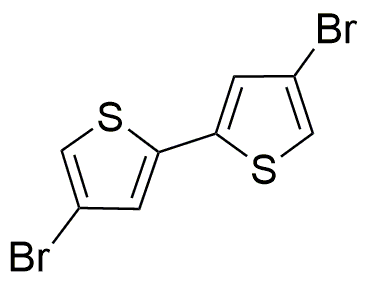4,4'-Dibromo-2,2'-bithiophene is widely utilized in research focused on:
- Organic Electronics: This compound is a key material in organic semiconductors, particularly in the development of organic photovoltaic cells and organic light-emitting diodes (OLEDs), enhancing energy efficiency and performance.
- Conductive Polymers: It serves as a building block for synthesizing conductive polymers, which are essential in flexible electronics and wearable technology, providing lightweight and adaptable solutions.
- Sensor Technology: The compound is used in the fabrication of chemical sensors and biosensors, benefiting industries like environmental monitoring and healthcare by enabling sensitive detection of various analytes.
- Material Science: In material science, it contributes to the creation of advanced materials with tailored electronic properties, useful in applications such as batteries and supercapacitors, offering improved energy storage capabilities.
- Research and Development: It is frequently employed in academic and industrial research to explore new applications in organic synthesis and materials science, driving innovation in various fields.
Información general
Propiedades
Seguridad y normativas
Aplicaciones
4,4'-Dibromo-2,2'-bithiophene is widely utilized in research focused on:
- Organic Electronics: This compound is a key material in organic semiconductors, particularly in the development of organic photovoltaic cells and organic light-emitting diodes (OLEDs), enhancing energy efficiency and performance.
- Conductive Polymers: It serves as a building block for synthesizing conductive polymers, which are essential in flexible electronics and wearable technology, providing lightweight and adaptable solutions.
- Sensor Technology: The compound is used in the fabrication of chemical sensors and biosensors, benefiting industries like environmental monitoring and healthcare by enabling sensitive detection of various analytes.
- Material Science: In material science, it contributes to the creation of advanced materials with tailored electronic properties, useful in applications such as batteries and supercapacitors, offering improved energy storage capabilities.
- Research and Development: It is frequently employed in academic and industrial research to explore new applications in organic synthesis and materials science, driving innovation in various fields.
Documentos
Hojas de datos de seguridad (HDS)
La SDS proporciona información de seguridad completa sobre la manipulación, el almacenamiento y la eliminación del producto.
Especificación del producto (PS)
La PS proporciona un desglose completo de las propiedades del producto, incluida la composición química, el estado físico, la pureza y los requisitos de almacenamiento. También detalla los rangos de calidad aceptables y las aplicaciones previstas del producto.
Certificados de análisis (COA)
Busque certificados de análisis (COA) ingresando el número de lote del producto. Los números de lote y de partida se pueden encontrar en la etiqueta de un producto después de las palabras "Lote" o "Lote".
Número de catálogo
Número de lote/lote
Certificados de origen (COO)
Este certificado de origen confirma el país en el que se fabricó el producto y también detalla los materiales y componentes utilizados en él y si se deriva de fuentes naturales, sintéticas u otras fuentes específicas. Este certificado puede ser necesario para cumplir con las normativas aduaneras, comerciales y regulatorias.
Número de catálogo
Número de lote/lote
Hojas de datos de seguridad (HDS)
La SDS proporciona información de seguridad completa sobre la manipulación, el almacenamiento y la eliminación del producto.
DownloadEspecificación del producto (PS)
La PS proporciona un desglose completo de las propiedades del producto, incluida la composición química, el estado físico, la pureza y los requisitos de almacenamiento. También detalla los rangos de calidad aceptables y las aplicaciones previstas del producto.
DownloadCertificados de análisis (COA)
Busque certificados de análisis (COA) ingresando el número de lote del producto. Los números de lote y de partida se pueden encontrar en la etiqueta de un producto después de las palabras "Lote" o "Lote".
Número de catálogo
Número de lote/lote
Certificados de origen (COO)
Este certificado de origen confirma el país en el que se fabricó el producto y también detalla los materiales y componentes utilizados en él y si se deriva de fuentes naturales, sintéticas u otras fuentes específicas. Este certificado puede ser necesario para cumplir con las normativas aduaneras, comerciales y regulatorias.


